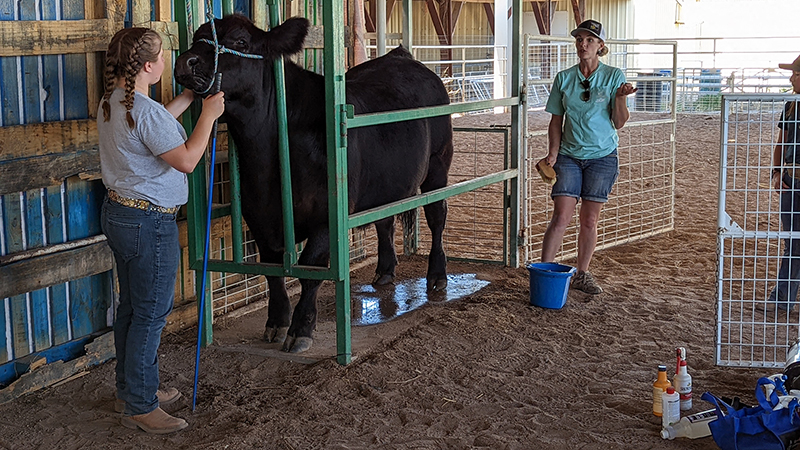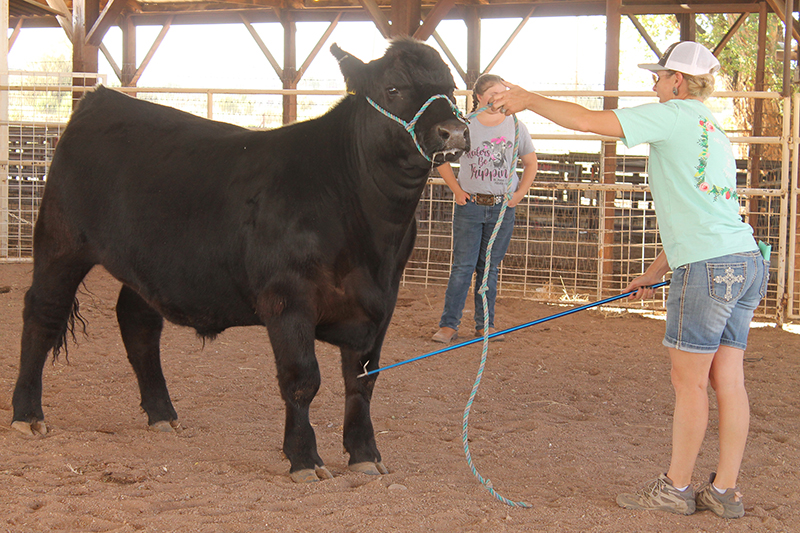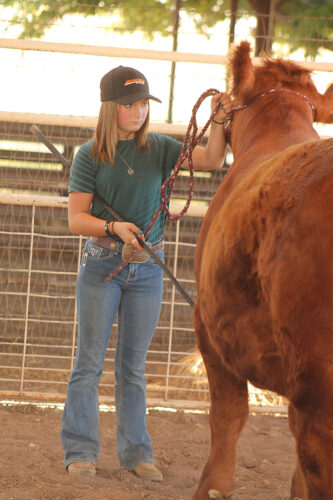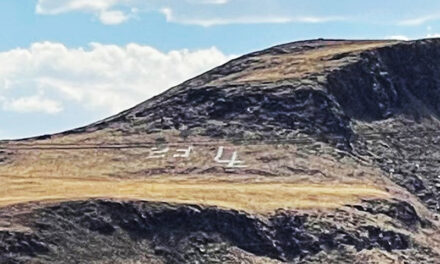

Julia M. Dendinger | News-Bulletin photo
Sara Marta, the Sierra County Cooperative Extension Service program director, demonstrates how to present a beef steer for judging during a recent clinic at the Valencia County Fairgrounds.
They have names like Disco and Dally, Gia and Tango. Some of them will go on to be part of a milking herd while others will become dinner.
As the heat of summer sets in, youth animal handlers across Valencia County settle in to the home stretch of getting their cows, goats, chickens, sheep, rabbits and more ready for county fair season.
To help the handlers finish strong, the Valencia County Fair management and the NMSU Valencia County Cooperative Extension Service brought experts from across the state to the Valencia County Fairgrounds to host animal handling clinics for everything from dairy and beef cows to poultry.
The treasurer of Win, Place and Show 4H Club, Allyson Marquez, 12, said she found the beef steer clinic “very, very helpful. I learned a lot about grooming; simple ways to hold (the steer) while walking.”
Marquez said the instruction on showmanship was the most helpful to her.

Julia M. Dendinger | News-Bulletin photo
Beef instructor Sara Marta, the Sierra County Cooperative Extension Service program director, right, used Jasmine Waid’s, left, steer Homer to demonstrate bathing and grooming techniques at a recent clinic.
“I was definitely doing it wrong,” she said with a laugh. “It helped me so much to know what I was doing instead of just winging it. It was also helpful to do hands-on, showing us physically, rather than just telling us.”
Learning to correctly handle your animal in the ring is key to a handler showing judges just how much work they’ve put into raising an animal. Everything from conformation, foot placement, hair and skin condition, fat on the animal and more is under scrutiny, and it can be rather subjective.
At the beef clinic last month, Sara Marta, the Sierra County Cooperative Extension Service program director, and her husband, Julian, talked to the handlers about some of the things judges like and don’t like, advising that trends in judging come and go.
Sara noted many judges now like to see handlers standing away from their animals, holding their heads high while using their control pole to scratch the brisket to calm the steer, where in the past, handlers were expected to stay close to the animal’s head.
“Some judges like it, some don’t. It is hard to predict,” Sara told the youngsters.
Allyson’s mother, Liz, always reminds her daughter that a judge’s scoring of her steer is only one person’s opinion.
“You can go to one show and not do good, then go to another and do well,” Liz said.
She said the advice from Sara on grooming products both homemade and store bought was also helpful.
Micaela Hidalgo, 17, is showing her brown Swiss dairy heifer this year, and admitted her heifer’s topline takes some work. The topline of an animal is the area along its spine from the shoulders back to the hips.
“You want the hair on the topline to look good, to have a strong topline. My Swiss is pretty weak,” Micaela said. “I have to pay more attention to it, comb it up. I can use hair spray or adhesive, although it’s hard to get out the adhesive. Like human hair, you can use heat, curl it and straighten it.”
When clipping for show, Micaela said the animal’s belly is also important with judges wanting to see a full, deep belly.
“You have to wash and dry the belly and fluff it,” she said.
Whether beef or dairy, all the bovines get regular washing and grooming, with handlers working on their hair daily to train it to fall at the most desirable angle. Not only does good grooming emphasise the form of the animal, it shows the overall care the animal has received.
“Judges look at overall conformation, and grooming is a big part,” Allyson said. “The healthier the skin, the more it shows you take care of your animal.”
Beef steers are judged on conformation as well as the amount of “cover” or body fat they have, since they will ultimately be sold for slaughter, Liz said.
“They go from the ring to market,” she said.

Allyson Marquez practices her handling techniques with her beef steer Big Red during a recent clinic. The event was held to help local youth livestock handlers polish their skills before the Valencia County Fair.
Dairy heifers are typically returned to the dairy farm they are leased from, said Micaela’s sister, 14-year-old Ashley, who began showing after seeing a show shortly after turning 9 years old.
“Me showing got Micaela involved,” Ashley said.
This will be her sixth year showing and her big sister’s fifth. Micaela began showing lambs before moving to dairy. She has also been judging in the dairy category for three years.
When judging a dairy cow, Micaela said the first thing a judge looks for is the height, length and overall size of the cow. In competition, judges also look at a cow or heifer’s dairy character, specifically the “hooks and pins” — the hips — of an animal.
“They also want to compare yours with the breed (standard),” she said, which can be challenging since most dairy cow characteristics are based on the Holstein breed.
“I show brown Swiss, so that can be kind of hard,” she said.
Showing in the dairy category is fun, Ashley said, since the animals are “sweet.”
“The community of dairy people is very nice and helpful,” she said.
Micaela said the dairy environment is very friendly and supportive even while being competitive.
“Dairy is a passion. It’s so much fun,” she said. “A big part is the bond you form with your cows. My brown Swiss is my baby. I have never loved a cow as much as this.”
In her third year of showing, Allyson said she began because of her love of animals, especially farm animals.
“I always wanted to try 4-H and just really wanted to try having animals,” she said. “I was told 4-H pigs are one of easiest and a lot of fun. I decided to try and see if I liked it and ended up really loving it.”
Raising and caring for animals is the lifestyle her mother grew up doing, so when Allyson decided to take on the challenge, Liz was supportive.
“Ally decided to do steers last year as more of a challenge. It’s a big expense for kids but very rewarding to watch them develop in maturity and responsibility,” Liz said. “They learn what happens when they leave a gate open and animals get loose.”
Training the steers has been gratifying, Allyson said, being a new challenge and being able to be successful.
“The best thing for me is to have money when I do well. I put in some (money) for college, some for a truck and some for my animals,” she said. “I’m proud of the animals when they cooperate and help me be successful.”
Not only is raising animals a commitment for the handler, but for their whole family, Liz said.
“The 4-H and FFA kids work their butts off. If they don’t get up (in the morning) and feed, their animal doesn’t eat,” she said. “And you have to have family involvement; it’s a big family commitment. This teaches them integrity and responsibility. It also teaches them at the end, the ultimate goal is to sell. This is somebody’s food, not pets.”
Julia M. Dendinger began working at the VCNB in 2006. She covers Valencia County government, Belen Consolidated Schools and the village of Bosque Farms. She is a member of the Society of Professional Journalists Rio Grande chapter’s board of directors.

















